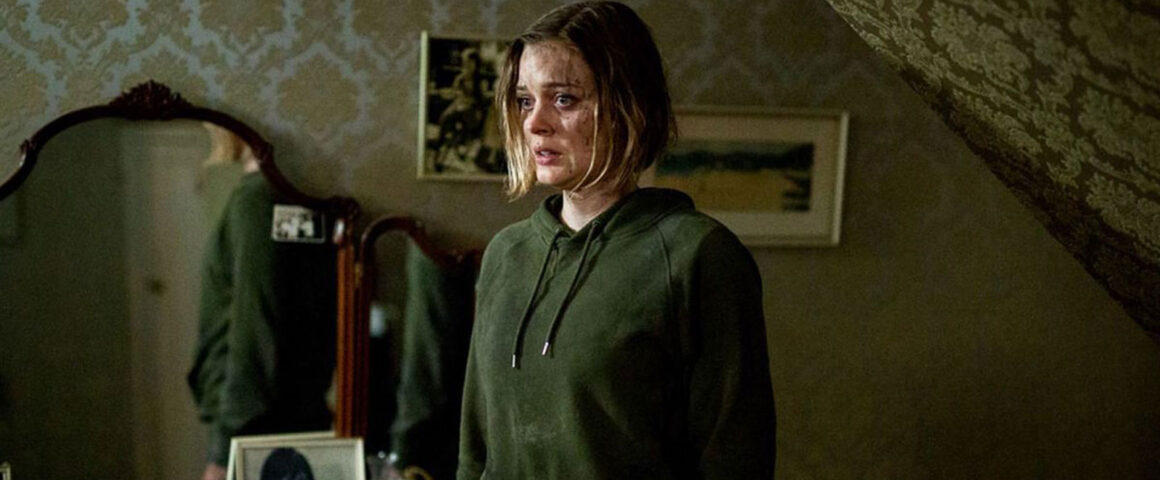Relic could be reductively described as “Hereditary” meets “Dark Water” with traces of “The Babadook.” The last reference might be due to this being a dour Australian horror involving an old-style house and maternal issues, but it’s a fine connection, nonetheless. While it also features small and sinister objects as well as strained family relationships, and a house that is steadily damaged by creeping water (and more), Relic stands as its own entity. Natalie Erika James’ feature debuts blends features of haunted house and body horror, delivering one of the creepiest and most emotional horror films of the year and a highlight of FrightFest 2020.
Relic is almost entirely a three-hander, focused on three generations of a family that come together reluctantly. When grandmother Edna (Robyn Nevin, “Gods of Egypt”) goes missing, her daughter Kay (Emily Mortimer, “Mary”) and granddaughter Sam (Bella Heathcote, “The Neon Demon”) come to search, oversee her home and, upon her reappearance, care for her. The film is therefore immediately a woman’s story, by women and about women. The gothic heroine is a well-established trope but often structured in relation to men. It could be argued that the film is hardly feminist due to its emphasis on the domestic space of Edna’s house, but Relic is a focus on women in the domestic space and the possible effects of this. Therefore, it serves as an interesting investigation of the domestic space and familial relations through a female lens.
While we spend most of our time with Edna, Kay and Sam, there is arguably a fourth character. Clichéd though it is to make this observation, the house is a character in its own right, complete with history and mystery. Within the haunted house genre, this house echoes many others with its extended corridors, locked rooms and piles of junk that present obstacles both physical and psychological. Another common trope is figures at the center of the frame while others appear at the edge, just visible enough to be unsettling. The opening scene sets the tone well, as we see an overflowing bath, water spilling out of the tub, across the floor and under the door in the same way as memories spill out of the mind. In an interview at FrightFest 2020, James explained that she was inspired to write the story from her own experiences with relatives suffering from Alzheimer’s, and the repeated image of spillage, including water, photographs and more, is a potent device for showing a disintegrating mind. While the water spreads, Edna stands naked and confused in her living room, and something else appears the frame. What it is we cannot tell, leaving us as confused as Edna. As the film progresses, we as well as Kay and Sam learn more, both about Edna and the house as a whole.
The other key element that makes Relic something special is the rot. Taglines typically tell you little about the film as a whole, but in this case, the tagline “Everything Decays” is an effective foreshadowing of what the film will give us. A strange mold or damp infects the house, discoloring the walls and, in one moment, providing one of the film’s few jump scares. It is testament to James’ directorial skill that a coat blowing in a draft, followed by the swift movement of it, can be frightening, and this is partly due to the uncanny meaning that she and production designer Steven Jones-Evans imbue in the decay. We are all familiar with seeing damp patches in our home, and it is a genuine concern (one also used to spooky effect in the Netflix series “The Haunting of Hill House”). In the case of Relic, the rot expresses several forms of decay beyond the structure of the house, including Edna’s mind as well as the distant relationships between the three women.
Pleasingly, James and co-writer Christian White do not clarify the family tension. Kay only speaks to her mother by rote and when she tries to have a meaningful conversation with her, Edna changes the subject. Sam has her own secrets and addresses her mother as “Kay,” indicating further tension. We are spared drawn-out exposition and backstory about what has caused these women to be distant, and the unspoken fractures adds to the oppressive atmosphere.
As is so often the case, the true horror here is family. Guilt, distance and recrimination loom large in the film, captured in subdued tones by the director of photography, Charlie Sarroff. Subdued is also how to describe the performances, as Mortimer bears the weight of the world with weariness but no self-pity. Nevin avoids the quirks that could be associated with the dotty old woman, while Heathcote is a far cry from the whiny youth that she could have been. Voices largely remain low, eyes downcast and even calls to each other are smothered by the invisible fog in the house. How many times can you hear someone say “Mum” before it becomes annoying? More than you hear in this film, as the call for “Mum,” echoed across generations, becomes ever more plaintive and tragic. Within the creeping dread and rotting structure, the central feeling is melancholia, regrets over lack of communication and time that could have been better spent.
Aside from this emotional baggage, the film also offers some skin-crawling body horror sequences as the body becomes a site of betrayal. Echoing David Cronenberg’s “The Fly,” an inexplicable deterioration assails our characters, something between transformation and consumption. Meanwhile, the haunting and unstable space becomes claustrophobic, especially as new discoveries are made but never explained. Dreams, memories and history inform the emotional tone, but we receive only impressions, making the overall effect all the more terrifying. A climactic set piece provides some shrieks and outright horror, but James never loses site of her central melancholic thread. Relic works as a scary ride, but it lingers in the memory like an indelible stain because it is, at heart, a tragic tale.



